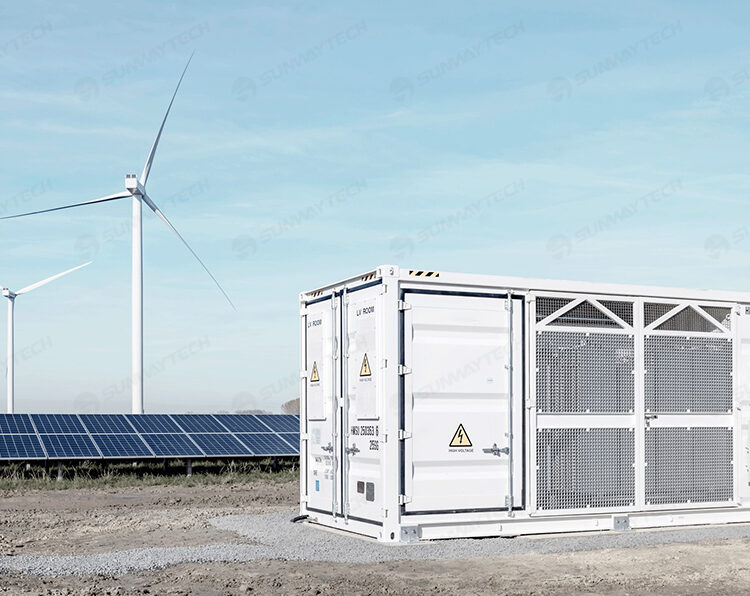From the perspective of the entire power system, energy storage application scenarios can be divided into three major scenarios: power generation side energy storage, transmission and distribution side energy storage, and user side energy storage. These three major scenarios can be divided into energy-based demand and power-based demand from the perspective of the power grid. Energy-based requirements generally require a longer discharge time (such as energy time shift) but do not have high requirements on response time. In contrast, power-type requirements generally require fast response capabilities, but generally, the discharge time is not long (such as system frequency modulation). In practical applications, energy storage technology needs to be analyzed according to the needs of various scenarios to find the most suitable energy storage technology. This article focuses on analyzing the three major application scenarios of energy storage.

Table of Contents
TogglePower generation side
From the perspective of the power generation side, the demand terminal for energy storage is power plants. Due to the different impacts of different power sources on the power grid, as well as the dynamic mismatch between power generation and power consumption caused by the difficulty in predicting the load side, there are many types of demand scenarios for energy storage on the power generation side, including energy time shifting, capacity units, load tracking—six scenarios including system frequency regulation, reserve capacity, and renewable energy grid connection.
Application types and typical characteristics of the power generation side of the energy storage industry
| Power generation side application | Application Type | Discharge time | Annual operating frequency | Response time |
| Energy time shift | Energy-based applications | 8h | 300 | Hour level |
| Capacity unit | Energy-based applications | 4h | 200 | Hour level |
| Load following | Power type application | 2h | 1000 | Minute level |
| System FM | Power type application | 15Min | 4000 | Second level |
| Reserve capacity | Power type application | 15min | 10 | Second level |
| Renewable energy grid integration | Energy-based/Power type application | 5min | 4000 | Second level |
Quantity time shifting is to achieve peak shaving and valley filling of electricity load through energy storage, that is, the power plant charges the battery during the period of low electricity load and releases the stored electricity during the peak period of electricity load. In addition, storing renewable energy’s abandoned wind and solar power and then moving it to other periods for grid connection is also energy time shifting. Energy time-shifting is a typical energy-based application. It does not have strict requirements on the time of charging and discharging, and the power requirements for charging and discharging are also relatively wide. However, due to the user’s electricity load and the power generation characteristics of renewable energy, the application of capacity time-shifting frequency is relatively high, more than 300 times per year.

Capacity unit
Since the power load varies in different periods, coal power units need to bear the peak load capacity, so a certain amount of power generation capacity needs to be set aside as the corresponding peak load capacity. This prevents the thermal power units from reaching full power and affects the economics of unit operation. Energy storage can charge when the electricity load is low and discharge when the electricity consumption peaks to reduce the load peak. The substitution effect of the energy storage system is used to release the capacity of coal power units, thereby improving the utilization rate of thermal power units and increasing their economy. Capacity units are typical energy-based applications. They do not have strict requirements on charging and discharging time and have relatively wide power requirements for charging and discharging. However, due to the user’s power load and the power generation characteristics of renewable energy, the application frequency of the capacity is time-shifted. Relatively high, around 200 times per year.
Load following
Load tracking is an auxiliary service that dynamically adjusts slowly changing loads to achieve real-time balance. Slowly changing continuously variable loads can be subdivided into base loads and ramp loads based on the actual operating conditions of the generator. Load tracking is mainly used for ramp loads, that is, by adjusting the output, the ramp rate of traditional energy units is minimized. , allowing it to transition to the scheduling instruction level as smoothly as possible. Compared with capacity units, load tracking has higher requirements on discharge response time, requiring the response time to be at the minute level.
System frequency modulation
Changes in frequency will affect the safe, efficient operation and lifespan of power generation and electrical equipment, so frequency adjustment is crucial. In the traditional energy structure, the energy imbalance in the power grid within a short period of time is adjusted by traditional units by responding to AGC signals. With the integration of new energy sources into the grid, the volatility and randomness of wind and solar energy have intensified the energy imbalance in the power grid in a short period of time. Traditional energy sources (especially thermal power) have a lag in responding to grid dispatching instructions due to their slow frequency regulation speed, and sometimes Wrong actions such as reverse adjustment will occur, so new demands cannot be met. In comparison, energy storage (especially electrochemical energy storage) has a fast frequency modulation speed, and the battery can flexibly switch between charge and discharge states, making it a very good frequency modulation resource.
Energy storage frequency regulation efficiency far exceeds other units
| Unit type | Power generation equipment climbing capability/(%*min-1) | Short-term ramp-up capability of the power grid/(MW*min-1) | Total power demand of corresponding power generation equipment/MW | Energy storage power/MW | The replacement effect of energy storage compared to traditional power sources |
| Hydropower unit | 30 | 10 | 33.33 | 20 | 1.67 |
| Gas unit | 20 | 10 | 50 | 20 | 2.5 |
| Coal-fired unit | 2 | 10 | 5500 | 20 | 25 |
Compared with load tracking, the load component change period of system frequency modulation is at the minute-second level, which requires higher response speed (generally second-level response). The adjustment method of the load component is generally AGC. However, system frequency modulation is a typical power application, which requires rapid charge and discharge in a short period of time. When using electrochemical energy storage, a large charge and discharge rate is required, which will reduce the life of some types of batteries, thus affecting their performance. Economy.
Reserve capacity
Reserve capacity refers to the active power reserve reserved in addition to meeting the expected load demand to ensure power quality and safe and stable operation of the system in case of emergencies. Generally, the reserve capacity needs to be 15~20% of the normal power supply capacity of the system, and the minimum The value should be equal to the unit capacity with the largest single unit installed capacity in the system. Since the reserve capacity is intended for emergencies, the annual operating frequency is generally low. If the battery is used alone to serve as reserve capacity, the economy cannot be guaranteed. Therefore, it needs to be compared with the cost of the existing reserve capacity to determine the actual cost. substitution effect.
Renewable energy grid integration
Due to the randomness and intermittent characteristics of wind power and photovoltaic power generation, its power quality is worse than traditional energy. Since the fluctuations of renewable energy power generation (frequency fluctuations, output fluctuations, etc.) range from seconds to hours, both Power-based applications also include energy-based applications, which can generally be divided into three categories: renewable energy energy time shifting, renewable energy power generation capacity solidification, and renewable energy output smoothing. For example, in response to the issue of photovoltaic power generation abandoning light, it is necessary to store the remaining electricity generated during the day for discharge at night, which is a time-shifted energy source of renewable energy. As for wind power, due to the unpredictability of wind power, the output of wind power fluctuates greatly, which needs to be smoothed, so power-based applications are mainly used.
Transmission and distribution side
The applications of energy storage on the transmission and distribution side are mainly three categories: easing transmission and distribution congestion, delaying the expansion of transmission and distribution equipment, and reactive power support. Compared with applications on the power generation side, there are fewer types of applications on the transmission and distribution side. At the same time, from the perspective of effects See more of the substitution effect.
Application types and typical characteristics of the transmission and distribution side of the energy storage industry
| Transmission and distribution side applications | Application Type | Discharge time | Annual operating frequency | Response time |
| Ease transmission and distribution congestion | Energy applications | 3h | 50 | Minute level |
| Delay expansion of power transmission and distribution capacity | Energy applications | 3h | 10 | Minute level |
| Reactive power support | Power type application |
<1min |
1000 | Second level |
Ease transmission and distribution congestion
Line congestion means that the line load exceeds the line capacity. The energy storage system is installed upstream of the line. When line congestion occurs, the untransmitted electric energy can be stored in the energy storage device. When the line load is less than the line capacity, the energy storage system will Line discharge. Generally, energy storage systems require a discharge time on the hour level and a running frequency of about 50 to 100 times. They are energy-based applications that have certain requirements on response time and need to respond on the minute level.
Delay the expansion of power transmission and distribution equipment
Traditional power grid planning or power grid upgrade and expansion costs are very high. In a power transmission and distribution system where the load is close to the equipment capacity, if the load supply can be met most of the time in a year, but the capacity is lower than the load only during certain peak periods, the energy storage system can be used to pass the smaller installed capacity. Capacity effectively improves the transmission and distribution capabilities of the power grid, thus delaying the cost of new transmission and distribution facilities and extending the service life of original equipment. Compared with alleviating power transmission and distribution congestion, delaying the expansion of power transmission and distribution equipment requires lower operating frequency. Considering the aging of the battery, the actual variable cost is higher, so higher requirements are put forward for the economy of the battery.
Reactive power support
Reactive power support refers to the regulation of transmission voltage by injecting or absorbing reactive power on transmission and distribution lines. Insufficient or excess reactive power will cause grid voltage fluctuations, affect power quality, and even cause losses to electrical equipment. Batteries can regulate the voltage of transmission and distribution lines by adjusting the amount of reactive power they output with the assistance of dynamic inverters, communication and control equipment. Reactive power support is a typical power-type application with relatively short discharge time but high operating frequency.
Power side
The electricity consumption side is the end point of electricity use, and users are the consumers and users of electricity. The costs and benefits on the power generation, transmission and distribution side are expressed in the form of electricity prices, which are converted into user costs. Therefore, the level of electricity prices will affect the user’s need.
Application types and typical characteristics of power consumption side of energy storage industry
| Subcategories | Application Type | Discharge time | Annual operating frequency | Response time |
| User time-of-use electricity price management | Energy applications | 1h | 200 | Minute level |
| Capacity charge management | Energy applications | 1h | 200 | Minute level |
| Improve power quality | Power type application |
10min |
100 | Second level |
| Provide power supply reliability | Energy applications | 1h | 100 | Millisecond level |
User time-of-use electricity price management
The power department divides 24 hours a day into multiple periods such as peaks, flat periods, and troughs, and sets different electricity price levels for each period, which is called time-of-use electricity prices. User time-of-use electricity price management is similar to energy time-shifting. The only difference is that user time-of-use electricity price management adjusts the power load based on the time-of-use electricity price system, while energy time-shifting adjusts power generation based on the power load curve.
Capacity charge management
Some countries implement a two-part electricity price system for large industrial enterprises in the power supply sector: the electricity price refers to the electricity price calculated based on the actual transaction volume, while the capacity electricity price mainly depends on the maximum value of the user’s electricity power. Capacity cost management refers to reducing capacity costs by reducing the maximum power consumption without affecting normal production. Users can use the energy storage system to store energy during low power consumption periods and discharge the load during peak periods, thereby reducing the overall load and achieving the purpose of reducing capacity costs.
Improve power quality
Due to problems such as the changing nature of power system operating loads and nonlinear equipment loads, the electric energy obtained by users has problems such as voltage and current changes or frequency deviations. At this time, the quality of the electric energy is poor. System frequency regulation and reactive power support are ways to improve power quality on the power generation side and transmission and distribution side. On the user side, the energy storage system can also smooth voltage and frequency fluctuations. For example, energy storage can be used to solve problems such as voltage increases, dips, and flickers in distributed photovoltaic systems. Improving power quality is a typical power-based application. The specific discharge market and operating frequency vary according to the actual application scenario, but generally the response time is required to be at the millisecond level.
Improve power supply reliability
Energy storage is used to improve the reliability of microgrid power supply. It means that when a power outage occurs, energy storage can supply the reserved energy to the end user, avoiding power interruption during the fault repair process to ensure power supply reliability. The energy storage equipment in this application must have high quality and high reliability requirements, and the specific discharge time is mainly related to the installation location.
?????? ?? ?? ?????? ???? ???????????!





